What is Pelvic Girdle Pain?
It was previously referred to as ‘symphysis pubis dysfunction’ or ‘sacro-iliac dysfunction’ which related to specific joints at the front of your pelvis and back of your hips. We now know that the pain can be more widespread than this and not specifically related to these joints and we refer to this pain as ‘pregnancy-related pelvic girdle pain’ or ‘PPGP’ for short. Up to 50% of women may be affected during pregnancy.
What causes pelvic girdle pain?
It was previously thought that the condition was related to a reduction in the stability of the joints; however new research has suggested that it is more likely to be caused by a natural pregnancy-related increase in the sensitivity of the tissues in and around your hips and pelvis.
The pelvis is one of the strongest and most stable structures in the body. But when the structures in the pelvis become more sensitive normal pressure and stretch sensations can generate louder messages which the brain may then interpret as pain. The vast majority of pain experienced with PPGP is caused by this increased sensitivity and therefore in spite of the presence of the pain there is no injury or damage to your pelvis. Anything which increases the sensitivity of your system (things like stress, anxiety, illness, poor nutrition, lack of sleep, worrying that the pain will never go, previous trauma) can further increase the volume of these messages which may then lead to more pain. Understanding that the pain is just an interpretation of information being received by the brain is the first step to being able to reduce the fear of the pain and as a result the actual amount of pain experienced.
Presentation of pregnancy-related pelvic girdle pain
You may experience pain when separating your legs such as getting out of the car or bed. The pain may come on during walking, standing or sitting for a period of time. You may struggle to stand on one leg when getting dressed or sit with your legs crossed. If you experience pain at these times it does not mean that you are causing any damage or that you need to worry that the pain is a sign of something threatening, but clearly it is a very unpleasant sensation that you would rather avoid.
What can I do to help?
When you feel your pain is increasing get into a relaxed, comfortable position and try to take some slow breaths feeling your tummy and chest expand as you breathe in deeply. To get out of bed straighten the knee of the leg on the side you are turning towards and bend the other knee. Bring your hand across towards your shoulder on the side you want to turn. Push Pregnancy-related Pelvic Girdle Pain through the heel of the bent knee leg and start to turn over without letting the bent knee collapse onto the straight leg (keep the thighs separated). Once you are on your side let both legs swing off the bed to sit up.
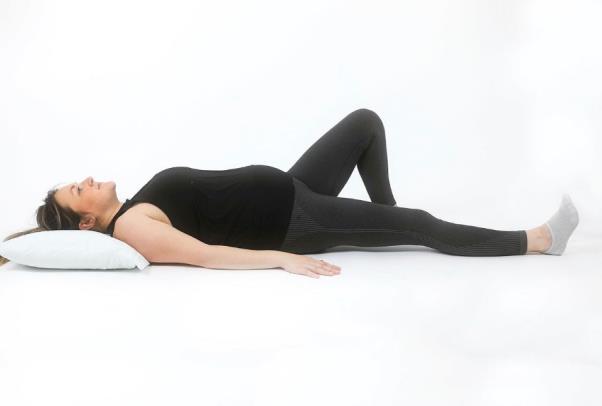
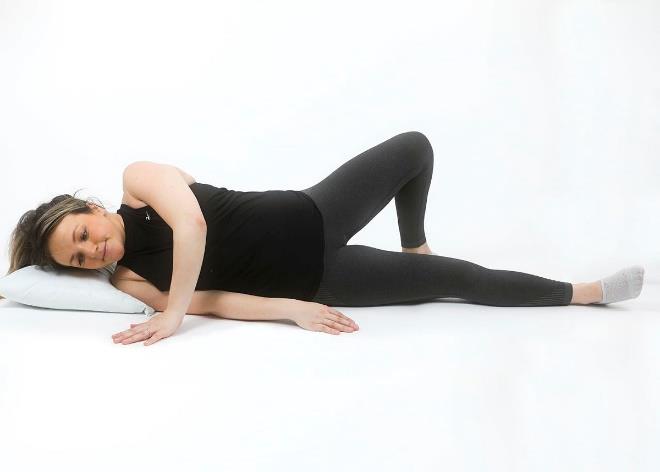
Try to avoid standing on one leg to get dressed and aim to change position regularly. There are a range of exercises which can help to promote normal movement which helps the brain not to fear movement, therefore reducing pain, and which can avoid any joint or muscle tightness from developing. The exercises should be comfortable – only move as far as you remain pain-free.
Pelvic tilt in standing
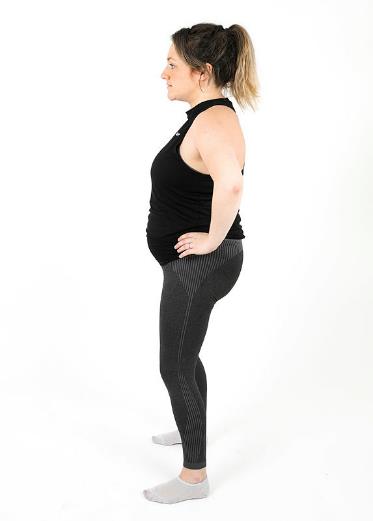
Stand with your knees soft (not bent but not locked straight) with your hands on your hips and gently tuck your tailbone under, bringing your pubic bone forwards and your bump upwards slightly. You could imagine your pelvis is a bucket full of water and you are trying to tip some out of the back of the bucket. Hold this position for a few seconds then return to the start position and repeat several times.
Pelvic tilt in sitting
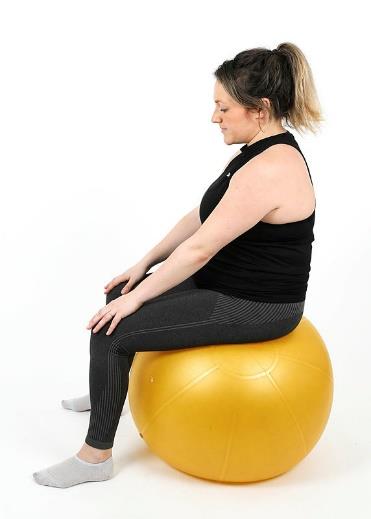
On a gym ball or seated on any surface practise gently rolling onto your tailbone, like you are slumping, and then growing up tall and rolling off your tailbone. If you are sitting on a gym ball you can also gently move your hips to left and right and then try combining these movements in order to move your hips in a circle.
Pelvic tilt in kneeling
On your hands and knees practice gently lifting and arching your back, tucking your tailbone under, and then lowering the middle of your back sticking your bottom out. Move between these two positions within what feels to be a comfortable movement and repeat a few times.
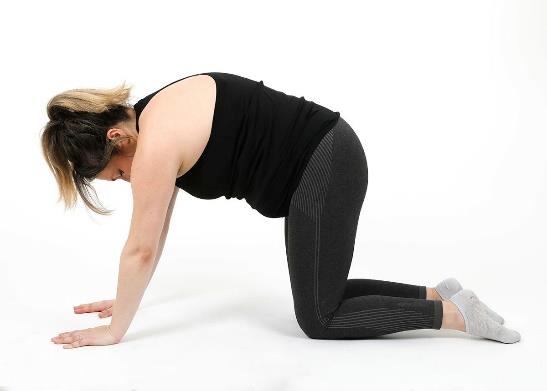
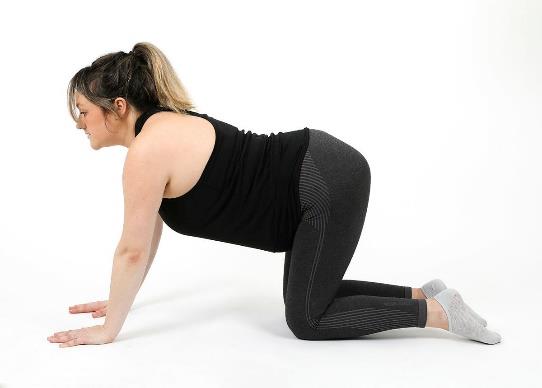
Back stretch using a gym ball
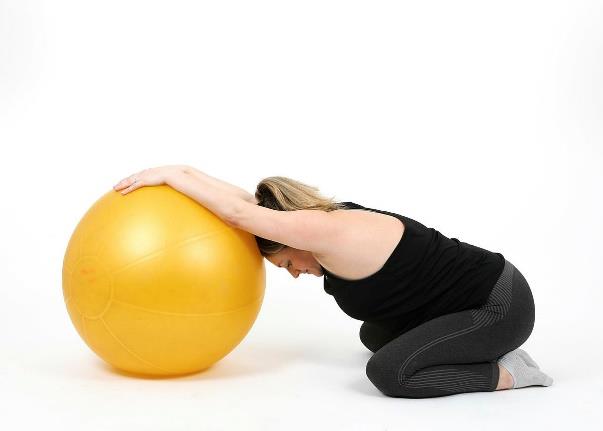
Kneeling on the floor with your hands resting on the gym ball in front of you, slowly roll the ball away from you so that your arms are straightening out and you should feel a stretch through the whole of your spine.
Butterfly pose
Lying on your back with pillows under your head and shoulders, bend your knees, place the soles of your feet together and allow your knees to open out as far as it is comfortable. Put cushions or pillows under the outer side of your knees so that it is comfortable to remain in this position for a few seconds. Then, as you breathe out, slowly bring the knees together and gently press your thighs inwards. As you breathe in open your legs and repeat this movement several times. Then place your feet on the bed/floor and as you breathe out gently lift your pelvis up into a bridge, only as far as it is comfortable to go. Breathe in as you slowly lower back down and repeat several times.
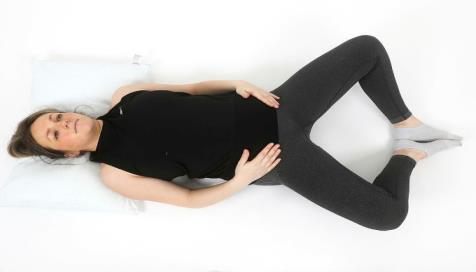
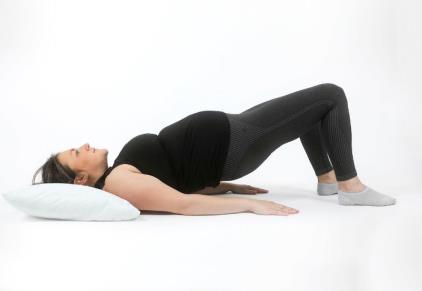
Pelvic floor exercises
In a comfortable position imagine you are trying to hold onto wind or as if you were trying to stop passing urine. You should feel a gripping, squeezing, lifting or pulling in sensation within the vaginal area. Try to keep breathing whilst you continue to hold this squeeze for a few seconds and avoid squeezing any external muscles such as the buttocks or leg muscles. Release the muscles and feel them fully relax for a few seconds. Repeat this several times. Then try doing the same exercise but release the muscle straight away so that you are practising a short version – repeat this a few times. Try to do these exercises regularly throughout the day.
Energy reboot
To give yourself a boost of energy at whatever point in the day you feel at your most tired you could try this exercise: lying on your back with your knees bent and your lower legs elevated (e.g. resting on the seat of the sofa or on a pile of pillows) start to slow and deepen your breathing, feeling your tummy rise and fill as you breathe in and fall as you breathe out. Once you feel happy with this start to gently tilt your pelvis in time with your breathing, alternately pressing the small of your back into the floor/bed and then relaxing it back to the start position. As you feel happy with this then add in ankle movements whereby you point your toes up to the ceiling and then away from you, like you are paddle kicking. Try to keep these movements going for five to ten minutes.
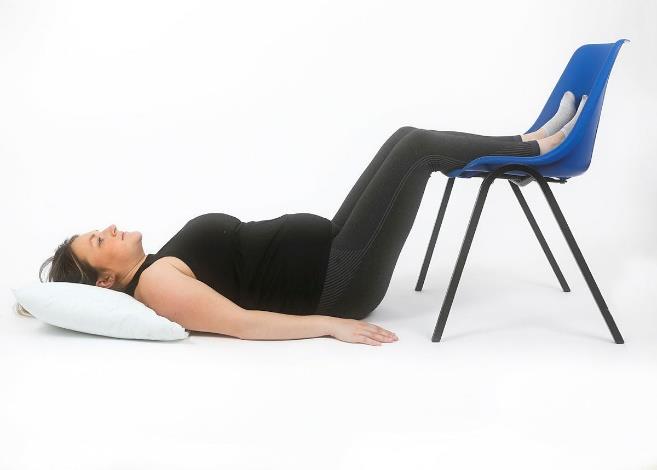

As stress, lack of sleep, poor nutrition and anxiety can all increase the sensitivity of the nervous system finding ways to improve your general wellbeing can decrease the sensitivity and therefore your pain. Regular use of warmth, a change in position and taking part in a form of general exercise that you enjoy can all help, as can mindfulness or hypnobirthing-type relaxation. Rest is important and try to break up spells of activity with short periods of rest in a comfortable position. Exercise in water and yoga have been found to help some people who experience PPGP. Going for a walk in a morning is often the best time as you have more energy at this point in the day and it can help you to sleep better at bedtime.
How can physiotherapy help?
If after following the advice given in this information sheet your symptoms are not more manageable then please refer yourself to physiotherapy using the following details:
POG Admin Support Team 01282 803587
You can download a printable version of this information here.
Please note this is a PDF and does not meet accessibility needs.


